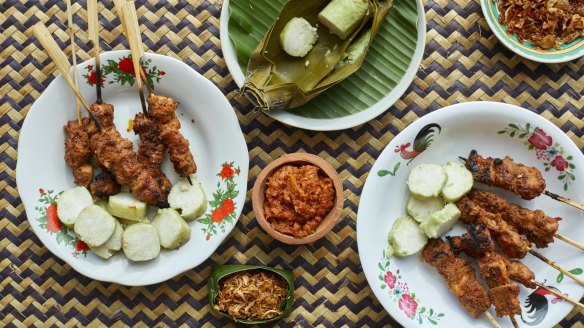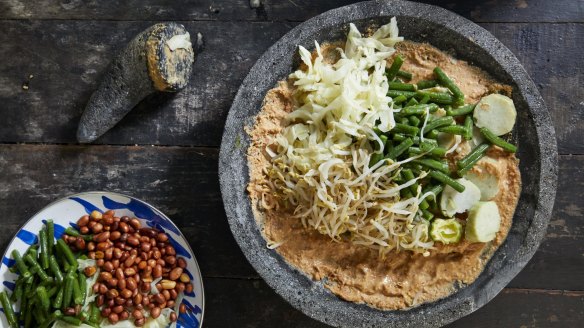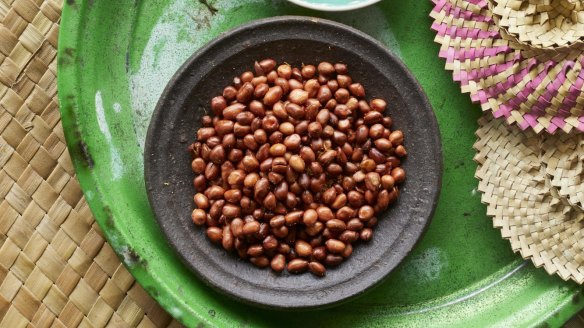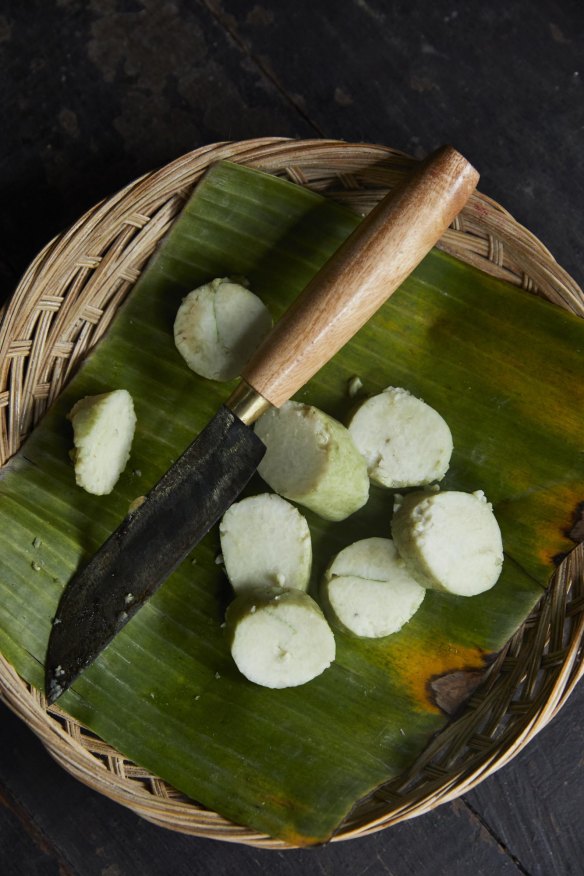How to make chicken satay skewers and other popular Balinese recipes

Before the pandemic, more than a million Australians visited Bali every year. But when work started to dry up for food writer Tjok Maya Kerthyasa and Balinese chef Wayan Kresna Yasa, they got together to pen Paon, sharing heirloom recipes and dishes from around the island.
"My niang's [grandmother's] generation learned and passed down knowledge orally, so the best recipes are rarely recorded on paper," Kerthyasa writes in the book's introduction.
"And restaurants seldom have the time and tools to match the depth, complexity and zing of Bali's home kitchens."

She hopes their book will change that.
"If you've never visited Bali, we hope these dishes will inspire you to make the trip," writes Kerthyasa.
"If you're Balinese or already well-versed in the cuisine, we hope you appreciate our efforts to share the island's flavours in a way that reflects its very unique spirit."
These recipes are sure to bring some of Bali's signature sunny flavours to your own paon (kitchen).
Sate tusuk sere tabia (Chicken satay with tamarind-chilli sauce)
Sate tusuk is the most straightforward kind of sate – just marinated meat on skewers. It's often made with chicken, pork or seafood, and it's deeply loved in all parts of Bali.
INGREDIENTS
- 500g chicken breast, skin removed, cut into 2.5cm cubes
- 25 thin bamboo skewers, soaked for 20 minutes
Marinade
- 100g long red chillies, seeds removed, sliced
- 3-5 bird's eye chillies, finely sliced
- 1 tsp shrimp paste
- 2 tsp tamarind pulp or paste
- 1 tsp lime juice
- 2 tbsp sea salt
- 3 tsp palm sugar
METHOD
- Using a mortar and pestle, crush the chillies into a smooth paste. Add the remaining marinade ingredients and crush to combine. Transfer to a bowl and set aside.
- Place the chicken in a mixing bowl, add the marinade and toss it by hand until the chicken is nicely coated. Let it marinate in the fridge for 1 hour.
- Preheat a charcoal grill or barbecue.
- Add four pieces of the chicken onto each skewer and grill for 3 minutes on each side, until the meat is cooked through, golden-brown on the outside and the marinade has started to caramelise. Serve with rice or lontong (rice cakes) and sauteed greens.
Makes 25 skewers

Tipat cantok (Vegetables and rice cakes in a spicy peanut sauce)
Tipat cantok is one of those dishes that tastes, looks and feels a little bit healthy and a little bit naughty all at once. When it's served at the markets, it's a joy to watch all the components being chopped, tossed and bundled together in brown paper – little parcels of peanut-fuelled nourishment to start the day. The key to any great tipat cantok is balance. You want it to be saucy, spicy, sweet and savoury. There should be a nice amount of crunch from the vegetables and starchiness from the rice cakes. Once you've mastered your perfect formula, you'll want it for breakfast, lunch and dinner.
INGREDIENTS
- 150g (½ cup) sea salt
- 150g cabbage, quartered
- 150g snake beans
- 150g bean sprouts
- 300g lontong, sliced into medium-sized discs (see recipe)
- 1½ tbsp fried sprouted beans, to serve (see recipe)
- 1 tbsp fried shallots, to serve
Peanut sauce
- 80g (½ cup) fried peanuts (see recipe)
- 3 garlic cloves
- 2-3 bird's eye chillies, sliced
- 220ml warm water
- 1 tbsp fried shallots
- 1½ tbsp kecap manis
- 1 tsp lime juice
- 1 tsp sea salt
METHOD
- To make the peanut sauce, crush the peanuts, garlic and chilli into a paste using a mortar and pestle, gradually adding small amounts of warm water until the peanuts become creamy. Then add the fried shallots, kecap manis, lime juice and sea salt and continue crushing until everything is combined. When it's ready, the peanut sauce should be a light brown colour. Adjust the seasoning to taste and set aside.
- In a large stockpot, add 3 litres (12 cups) water and the salt, and bring to the boil over a medium heat. Add the cabbage and snake beans and cook for about 10 minutes. Remove the vegetables from the pot using a slotted spoon and submerge them in a large bowl filled with ice water to stop them cooking.
- Add the bean sprouts to the boiling water and cook for about 5 minutes. Remove from the pot using a slotted spoon and transfer to a large mixing bowl to cool.
- Add the cabbage, snake beans and lontong to the bean sprouts, pour over the peanut sauce and toss, making sure everything is liberally coated in the sauce. Adjust the seasoning to taste by adding more salt, lime juice and kecap manis if needed.
- Serve with fried peanuts and fried shallots sprinkled over the top.
Serves 4

Kacang tanah goreng (Fried peanuts)
You can use fried peanuts as a side, a snack or to make peanut sauce. They're sold in little packets at most warungs (local eateries) in Bali.
INGREDIENTS
- 500ml (2 cups) vegetable oil
- 1kg (4 cups) shelled, raw peanuts
- ½ tbsp sea salt
METHOD
- Heat the oil in a wok over medium heat for about 5 minutes. Slowly add the peanuts and fry, stirring constantly, so that all the peanuts cook evenly, for about 8-12 minutes, or until golden-brown.
- Remove the peanuts using a spider ladle or slotted spoon and place on a tray lined with paper towel to drain off excess oil.
- Sprinkle the peanuts with the salt and store in a glass container for 3-4 days.
Makes 1kg
Kacang mentik goreng (Fried sprouted beans)
Sprouted beans are smaller and earthier than peanuts and have a considerable amount of crunch. You'll need to soak and sprout the beans first, so start this recipe a day or two ahead.
INGREDIENTS
- 500g small, dry red beans, such as adzuki beans
- 500ml (2 cups) vegetable oil
- 1 tsp sea salt
METHOD
- Place the beans in a tub or large bowl along with 1 litre (4 cups) water to rehydrate for about 10 hours.
- Strain the beans and line the empty tub with thick, damp paper towel. Place the beans on top and cover with more damp paper towel. Let the beans sit at room temperature overnight, at least 12 hours. The beans are ready when they have sprouted and have a fresh, crunchy texture.
- Heat the oil in a wok over a medium heat for about 8 minutes, or until it reaches smoke point, then slowly add the sprouted beans. Fry the beans for about 8-12 minutes, stirring constantly, until they're crisp and golden-brown.
- Remove the beans from the oil with a spider ladle or slotted spoon and place on a tray lined with a paper towel to soak up excess oil. Sprinkle with the salt and store in an airtight jar for up to 2 weeks.
Makes 250g

Lontong (Boiled rice cakes)
There are generally two kinds of savoury rice cakes in Bali. The first is known as tipat and is made from uncooked rice steamed inside diamond-shaped pouches woven out of young palm leaves. The second is known as lontong and is made from cooked rice wrapped in banana leaves in the shape of a log. Both are boiled to form dense, sticky, savoury rice cakes that pair wonderfully with sates and other soupy or saucy dishes.
INGREDIENTS
- 4 banana leaves (20 × 20cm) (see note)
- toothpicks, bamboo sticks or butcher's twine
- 400g (2½ cups) steamed white rice
- tipat cantok, to serve (see recipe)
- sate, to serve
METHOD
- Prepare the banana leaves for wrapping and use the guide (see tips) to wrap the filling.
- Place the banana leaf parcels in a medium stockpot along with 3 litres (12 cups) water and bring to the boil. Cook over a medium heat for about 2 hours, or until the logs are firm but the rice inside the leaves still gives way when you give it a gentle squeeze.
- Remove the lontongs from the pot using tongs and place on a rack to cool completely. Carefully unwrap the parcels, slice the rice cakes and serve them with tipat cantok and sate.
Makes 4
Note Banana leaves are often available fresh or frozen at Asian supermarkets. If you use frozen leaves, simply defrost them at room temperature when you start cooking.
- To make a banana leaf parcel, place two pieces of banana leaf on top of each other, with the bottom leaf's top (glossy) side facing the bench and the top leaf's glossy side facing you. The veins of both leaves should face in the same direction.
- Place a quarter of the steamed rice in each parcel along the grain of the banana leaves.
- Fold the leaves over the filling and roll into a log. Work with the veins of the leaves, not against them, so they don't tear.
- You can fasten the ends with a toothpick (or a thin bamboo stick if you want to use the traditional way), or tie them shut with butcher's twine, nice and tight – you want to make sure water won't enter the parcel when cooking. Ensure there are no tears in the banana leaves.
Serves 4
This is an edited extract from Paon: Real Balinese Cooking by Tjok Maya Kerthyasa and I Wayan Kresna Yasa, published by Hardie Grant Books, RRP $50. Photography: Martin Westlake. Buy now
Appears in these collections
From our partners
Original URL: https://www.watoday.com.au/goodfood/how-to-make-chicken-satay-skewers-and-other-popular-balinese-recipes-20220609-h24c70.html